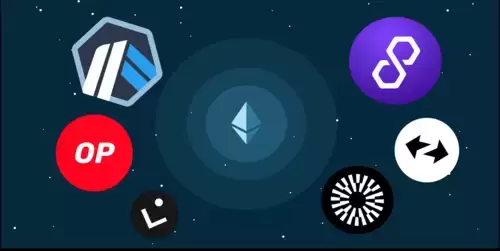 |
|
 |
|
 |
|
 |
|
 |
|
 |
|
 |
|
 |
|
 |
|
 |
|
 |
|
 |
|
 |
|
 |
|
 |
|
Cryptocurrency News Articles
The Race to New Bitcoin Highs and Lows Begins as BlackRock Pushes Digital Gold
Jul 06, 2024 at 07:20 pm
Half a year after Bitcoin ETFs launched, it is safe to say that they have been the most successful ETF launch in history, having generated a $309.53 billion volume.

Half a year after Bitcoin ETFs hit the scene, they have proven to be the most successful ETF launch in history, generating a volume of $309.53 billion. On the first day of trading alone, spot-traded Bitcoin ETFs raked in $4 billion, crushing the previous record holder, Gold ETF (GLD), which took three days to clock up capital inflows of over $1 billion.
This is all the more impressive considering that Bitcoin is a novel asset compared to ancient gold. The trend clearly indicates that Bitcoin is a better fit for the digital age. But what is that purpose?
BlackRock’s Head of Thematic & Active ETFs, Jay Jacobs, recently noted that Bitcoin is a “potential hedge against geopolitical and monetary risks”. By now, most people are aware that central banks’ ability to tamper with the money supply brings many moral hazards, from record-breaking budgetary deficits to inflation as an extra layer of taxation to cover those wild spending sprees.
Gold is less suited to counter that ability because it is physical, confiscatable, and not truly limited. Being one-tenth the size of the gold market, Bitcoin's price is more volatile, but it is also a more attractive gains machine.
Now that Bitcoin ETFs have simplified and institutionalized access to more exciting digital gold, what steps are needed to ensure that trend continues?
Ensuring Network ReliabilityOwing to its proof-of-work (PoW) consensus mechanism, Bitcoin is inherently dual-natured. It is a digital asset that is anchored into the physical reality of energy and hardware assets. This underlying foundation gives Bitcoin its value as a decentralized counter to central banking.
In turn, the components of that foundation, the Bitcoin network, have to scale up to continue the institutional intake. Presently, the Bitcoin network handles around 412k transactions per day, nearly double from two years ago. Although the median transaction fee oscillates depending on network load, it rarely exceeds $5 per transaction.
In parallel, their networks have to scale to ensure the Bitcoin network can handle orders of magnitude greater load coming from institutions. To increase their stability and robustness, they have to tackle multiple network components, from software and servers to hardware and internet connection.
Scalable Blockchain SolutionsJust as IBM made significant contributions to developing current large language models (LLM), the legacy computer company also made a strong case for blockchain scaling with IBM Blockchain. This immutable ledger is based on an open-source Hyperledger Fabric framework with a complete set of tools for building blockchain platforms.
Such a framework could interface with the Bitcoin ecosystem via atomic swaps, for example, through virtual vaults with timed smart contracts. Similarly, Visa proposed an experimental Universal Payment Channel (UPC) framework as a hub for blockchain network interoperability. International banking network SWIFT had already completed the second test phase for atomic settlement capability.
Zooming out, a picture emerges of enterprise-grade blockchain solutions for institutions, interlinking with international hubs and intermediating with institutions that handle exposure to Bitcoin, such as Coinbase.
Dependable ServersPowering scalable blockchain solutions comes in the form of hardware. These can either be internal servers, via customized solutions offered by Broadcom, or offloaded to external options like the Canton Network.
As a decentralized infrastructure, the Canton Network is a network of networks, building on Daml smart contract language and micro-services architecture. The latter allows for each service plugged in to to have its own server, expandable with more CPUs and storage.
Using atomic settlements, the Canton Network makes real-time settlement possible across different blockchain apps. By outsourcing services to such networks, businesses and institutions can focus on core features rather than IT infrastructure management, including the maintenance of CPUs, dedicated GPU hosting to diversify into AI support, and other essential hardware.
Internet ConnectivityNodes in any blockchain network have to communicate continuously to validate transactions and execute settlements by adding them as the next block on the blockchain ledger. In other words, internet connectivity necessarily involves redundancy and failover strategies.
For example, when Solana experienced network downtime problems, co-founder Anatoly Yakovenko hired Jump Crypto to develop Firedancer as a secondary network validator client to fortify network throughput and stability.
With broader solutions like the Canton Network, enjoying support from the Big Tech and Big Bank, redundancies, multi-channels, backup systems, and load balancing are already baked into the DLT cake.
Enhancing Network PerformanceIt is inherent in all types of computer networks to suffer from some level of packet loss and jitter. Packet losses can happen due to overwhelming demand, causing congestion, network interference, faulty software or hardware, and data corruption on hard drives.
Transmission Control Protocols (TCP) deal with packet losses by retransmitting data, which causes delays, or by Forward Error Correction (FEC), which adds redundant data to packets, removing the need for retransmission. The Bitcoin Relay Network uses FEC to this effect, as does the Blockstream Satellite network, as an alternative avenue to receive Bitcoin blockchain data.
As for jitter
Disclaimer:info@kdj.com
The information provided is not trading advice. kdj.com does not assume any responsibility for any investments made based on the information provided in this article. Cryptocurrencies are highly volatile and it is highly recommended that you invest with caution after thorough research!
If you believe that the content used on this website infringes your copyright, please contact us immediately (info@kdj.com) and we will delete it promptly.




























































